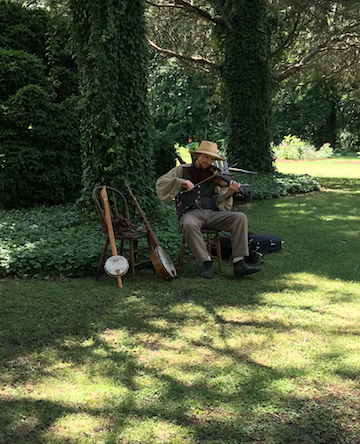Finding heritage in plants
Published 12:46 pm Wednesday, June 27, 2018

- Barrow Wheary plays outside of the gardens at Brickland.
Recently I enjoyed the pleasure of attending a fundraiser in celebration of the 200th Anniversary of Brickland a historic antebellum property in Lunenburg County. I enjoyed walking through the many gardens containing an impressive assortment of delightful plants, many of which were in full bloom. Most planted by and all lovingly cared for by Brickland’s current owners.
The collection of towering trees (some centuries old) that line the drive and surround the elegant stately brick structure and its grounds are impressive. Their presence immediately gives one the notion that you have just arrived somewhere very special.
The historic home in all its grandeur and beauty on its own has the power to transport one’s thoughts to a different time in history. However, while walking the grounds under the green canopy of the mighty old hardwoods I really felt as though I was in another place in time and that I might turn a corner and meet up with someone from the revolutionary era.
While admiring one of the cutting gardens with other guests, surrounded by natural beauty at every turn Mr. Barrow Wheary played the fiddle and banjo outside of the Parterre. The atmosphere was surreal and I could not help but to ponder thoughts of Brickland’s past gardeners and what the grounds looked like in the 1800s. Were there clues left from the past as to where particular gardens may have been located on the property? If so how would one recognize them I wondered to myself.
Gardening in the early 19th century looked much different from what most would recognize as a garden today. Back then unless you enjoyed the status of great wealth, most homes had one garden located close to the home and proportionate to the size of the family living there. Usually modest and containing only vegetables for eating and herbs to be used medicinally and for seasoning, all were grown together with no apparent thought to organization in regards to aesthetics. Individual plants were put where the gardener thought they would grow best in the garden.
Aside from topographical anomalies in the ground or buried artifacts that might provide clues of past gardens, items of heritage can provide much history and information. When researching properties such as Brickland that have been transferred down one family’s line throughout decades and even centuries, pertinent information such as demographic location and specific plant specimens and their origin can sometimes be found documented in building prints, old deeds, personal letters and even archived newspapers.
Clues to the interests of past gardeners can also be found in the plants themselves. Brickland contained many. The 200-year-old boxwoods and the very old Osage orange trees were the oldest and most impressive among them. Also of historical interest were the Blackberry Lillie’s planted in the old post office court yard. I wondered if perhaps they had originated from Thomas Jefferson’s prized plants, after all it is hearsay that the 200-year-old boxwoods were a gift from him to the original land grant owner. The row of Korean Spice Viburnum planted along the walk from the herb garden to the Parterre also had me thinking of how thoughtful the gardener was at the time to have planted them directly in front of the homes kitchen windows in order to take in their sweet scent of clove in the spring.
Steeped in historical heritage every square inch of it Brickland is one of Lunenburg’s greatest treasures.
Dawn Conrad is a columnist for The Kenbridge- Victoria Dispatch. She can be reached at conrad.gardenmuse@ gmail.com or fb.me/ Conrad.gardenmuse.


